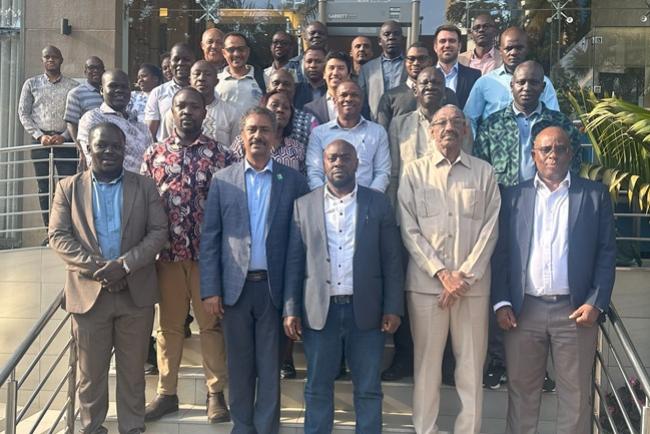Nile Basin Seasonal Hydrological Outlook: October - December 2025 Season

Summary and Key Message on the Nile Basin Seasonal Hydrological Outlook and Advisory for October-December (OND) 2025 Season.
1.0 Background
The Nile River Basin supports over 300 million people across 11 countries, OND (October–November-December) is a key hydrological season, signalling rains in equatorial regions and the start of the dry season in the Ethiopian Highlands. The Nile Basin Initiative (NBI), through its Regional Expert Working Group on Hydrology, assessed climate forecasts from ICPAC (GHACO F 71) and Member States’ National Meteorological Services and translated them into hydrological outlook, implications and advisories.
2.0 Performance of June-July-August-September (JJAS) 2025 Season
Reviewing the performance of the Nile Basin Seasonal Hydrological Outlook and Advisory for JJAS 2025, revealed that a near- to above-normal rainfall was recorded in Ethiopia, Kenya, eastern Uganda, and South Sudan; drier conditions in Rwanda, Burundi, and parts of western Uganda. The implications on basin hydrology included most rivers and lakes in Eastern Nile (Blue Nile, Atbara, Baro-Sobat, Lake Tana) recorded above normal flows and water levels, while Nile Equatorial Lakes (NEL) region mostly saw declining lake levels (notably Lake Victoria, Lake Kyoga, Lake Albert) and river Kagera, Nzoia, Mara and others. In addition, flash floods were widespread in Ethiopia, Sudan, South Sudan, and Uganda, affecting millions of people and Riverine floods were limited but occurred locally around Lake Tana (Gumara River). South Sudan also registered sporadic flooding in areas of Malakal, Bor, Bentiu, and Torit displacing thousands of people triggering humanitarian crisis. Conversely, some parts of Rwanda and Burundi experienced the worst dry spell in a decade that saw reduced water levels and flows in most river, lakes and reservoir below the long term mean with pronounced water scarcity in some urban areas such as Kigali Rwanda.
3.0 Climate and Hydrological Outlook for October-November-December (OND) 2025 Season
Above-normal rainfall likely in southwestern and northeastern Uganda and much of south and northeastern parts of South Sudan. Equally, below-normal rainfall expected in much of Rwanda, Burundi, western Kenya, and parts of South Sudan and Ethiopia. Also, a warmer-than-normal temperatures across most of the basin mostly Sudan and parts of Ethiopia with enhanced levels of
evaporation rates. Implications on basin hydrological include slight rise in river water levels in October, then decline through November–December mostly in the NEL regions and declining water levels to near to below the long-term mean in most rivers in the eastern Nile region (Blue, Nile, White Nile, Tekeze, Atbara, Baro Akobo Sobat etc). Equally, Lake Victoria water levels are expected to rise by 27% above long-term mean but remain below 2024 recorded water levels) while Lake Tana, Kyoga, and Albert likely to decline. Most reservoirs in the Eastern Nile, replenished during the JJAS season are expected to experience reduced inflows in some regions, requiring careful planning management for hydropower, water supply for domestic and irrigation.
4.0 Country-Level Highlights
- Burundi: Near-average to below-normal rainfall; risk of localized flooding; need for water harvesting and soil conservation.
- DR Congo: Near- to above-normal rainfall; risk of river flooding near Semliki and Rutshuru; benefits for agriculture but potential crop damage from heavy rain.
- Ethiopia: Most parts of the basins forecast below-normal rainfall (except southeastern basins with normal); declining Lake Tana and reservoir levels; need for water conservation and dam management.
- Kenya: Near- to slightly below-normal rainfall in Lake Victoria Basin; low flood risk along and lower reaches of Nzoia, Nyando, Yala, Sondu Rivers.
- Rwanda: Near-normal to above-normal rains in northwestern; flood risk; eastern Rwanda may face water scarcity and low flows hence efficient use and planning as well promoting rainwater harvesting technologies.
- South Sudan: High water levels will sustain current flooding into November; prolonging the current humanitarian crisis with recession in December; dykes and drainage systems need reinforcement; coordination of humanitarian assistance is key for recovery of the affected population.
- Sudan: Mixed conditions – possible floods in southern/western regions, drought risk in central/northern regions; risk of reduced Nile flows from mid-October to December hence efficient use of current storages should be promoted.
- Tanzania: Average to below-average rainfall in most areas; Lake Victoria Basin rivers to remain near/above normal, supporting hydropower (Rusumo).
- Uganda: Normal to above-normal rainfall in northeastern and southwestern; rising rivers and lake levels may cause localized floods, especially in Rwenzori region.
5.0 Key Basin-Wide Recommendations and Advisories
- Continuous real-time monitoring of rivers, lakes, and reservoirs.
- Early warning dissemination via SMS, radio, community meetings.
- Water conservation and storage to prepare for potential dry spells.
- Flood preparedness: dyke reinforcement, clearing urban drainage, prepositioning relief supplies.
- Hydropower & irrigation management to optimize releases and maintain water supply.
- Health measures: prevent waterborne disease outbreaks after floods and provide clean water.
